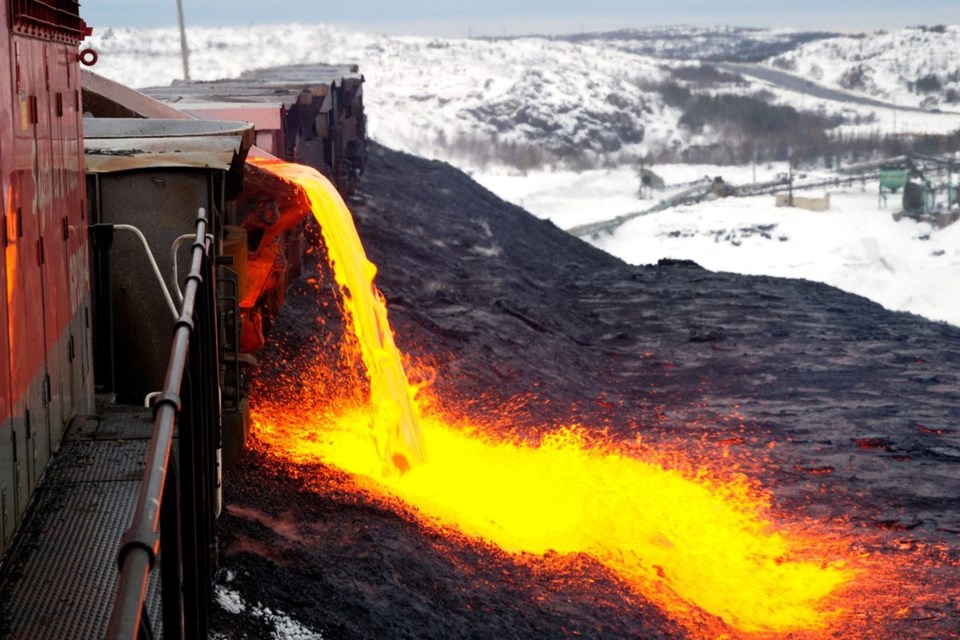For a long time, we’ve thought that the girls going out to bingo and the boys getting stinko was the only thing to do on a Sudbury Saturday night.
However, from all of the responses received after the previous article, it turns out that there is no finer sight on Sudbury’s most special night than watching the slag pour (while still trying to think no more of INCO, of course).
As reader Tim Bolton stated, “we used to go watch the slag pour (in) the same way you would go see the sunset or a drive-in movie.”
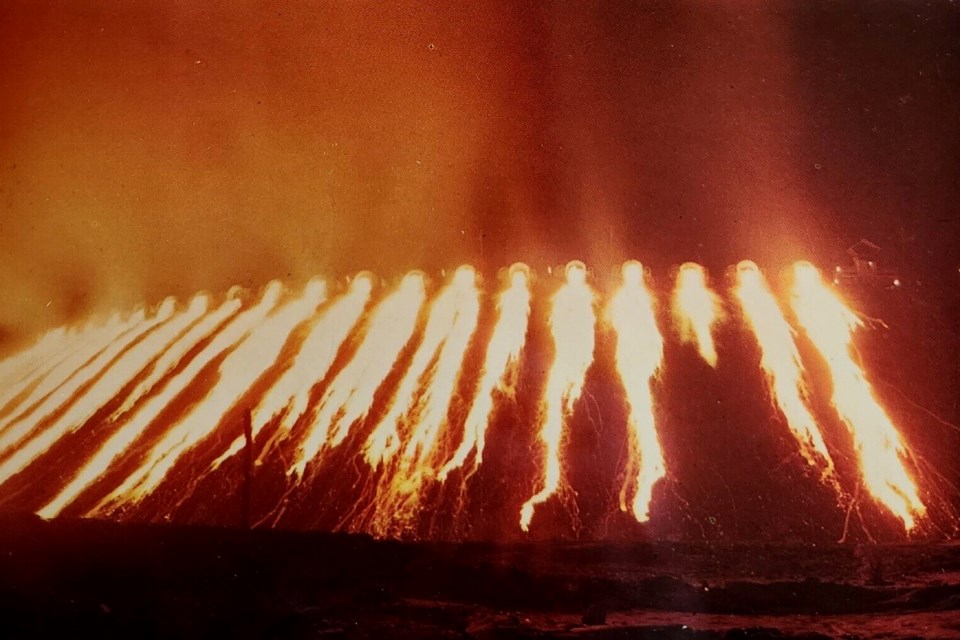
As with a sunset, the visual aspect, the multitude of colours that presented themselves was one of the things that has stuck most visibly within the mind’s eye of many of our readers. Sharon Sheeler, reaching back more than 60 years into the past, having lived in Sudbury from 1955 until 1962 “clearly remember(s) seeing the night sky lit up in brilliant reds and oranges.” It was “quite a sight!”
Donja Jarrett wrote that “this (topic) brings back memories from life in the West End (with the) sky lit up at night.” She added that “in the winter, up in the snow-covered rocks behind the houses, the snow was pink and the sky, red.” This, she found to be “quite magical” as it was, amazingly, “all from the dumping of molten slag.”
Petra Casas spoke of the warm feelings evoked from the simple reflection of the red in the sky from the slag being dumped entering through the windows of her childhood home.
“It was always such a pretty sight,” she wrote, “and also kind of comforting, as it meant we were home.”
And, for reader Linda Derkacz, “the brightness of slag dumping, being a young child, was a sight (which) we all looked forward to.” While Cathy Gauthier, although she lived all the way in Whitefish, “could see the glow in the sky where we lived in.”
Bringing us into the present, a couple of readers were quick to point out the slag pour does continue to this day (albeit mostly hidden from view), and that it still dazzles with the same visual experience which many other readers remember.
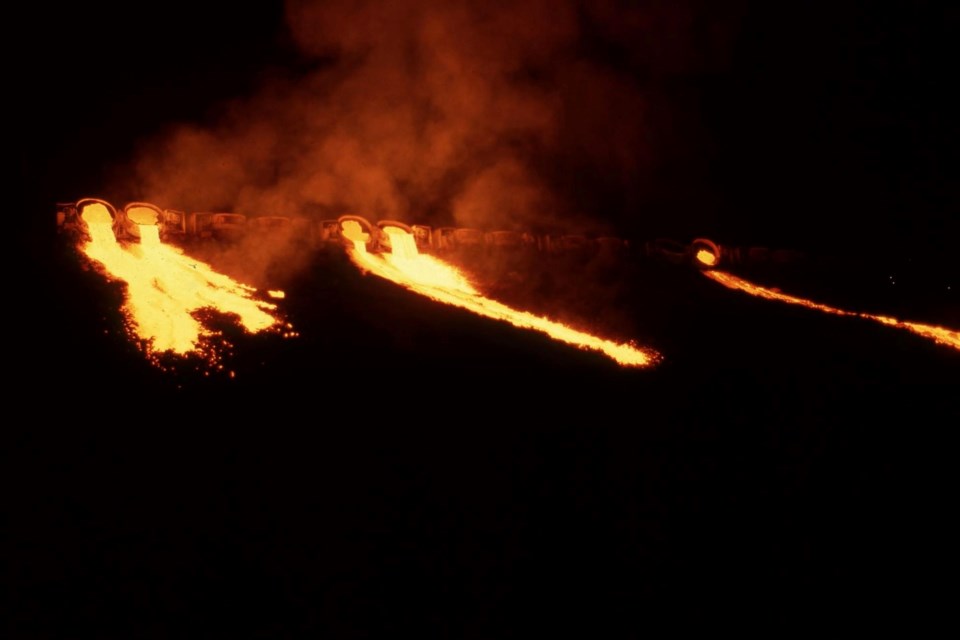
Barb Giroux writes that she “live(s) in the West End just in the gulley where the Big Nickel Road turns from Elm Street (and) sees the sky light up in the evening regularly. It's awesome to see for sure. Such a beautiful sight.” And, reader Sherri Smith does not have to go far herself as she “can watch the glow from my back porch (while) it brings back memories.”
An interesting thing to note, from the memories of those who emailed or commented at the Sudbury Then and Now Group, is that a very real commonality of experience existed among the families who made it a ritual to visit the slag dump.
For reader Carol Laprairie, the “favourite family night would be to go to the Dairy Queen, then go park and wait till it got dark to watch the slag dump.”
Linda Derkacz said her father worked for INCO so he had a line on the slag dumping schedule. This made Saturday nights in the summer a real treat for his family. As she wrote, “excited we were, we'd put on our pyjamas, pile into the old station wagon, drive to Sudbury from Val Therese taking the Clarabelle Road into Copper Cliff (with the) first stop (being) Dairy Queen on Lorne Street for their delicious cone.”
Another reader Tracy Leroy shared that her family followed the same tradition as well, since “watching the slag dumping was always awesome. We would go to DQ for a baby cone before and then watch the show. It was always a treat!”
Melissa Geevee reminisced that her “parents would bundle all the little kids into the car and drive in the darkness to park close to the base of the slag pile and wait for the gorgeous orange flow to begin. As a little kid it was a real treat to stay up late to see this awesome spectacle.”
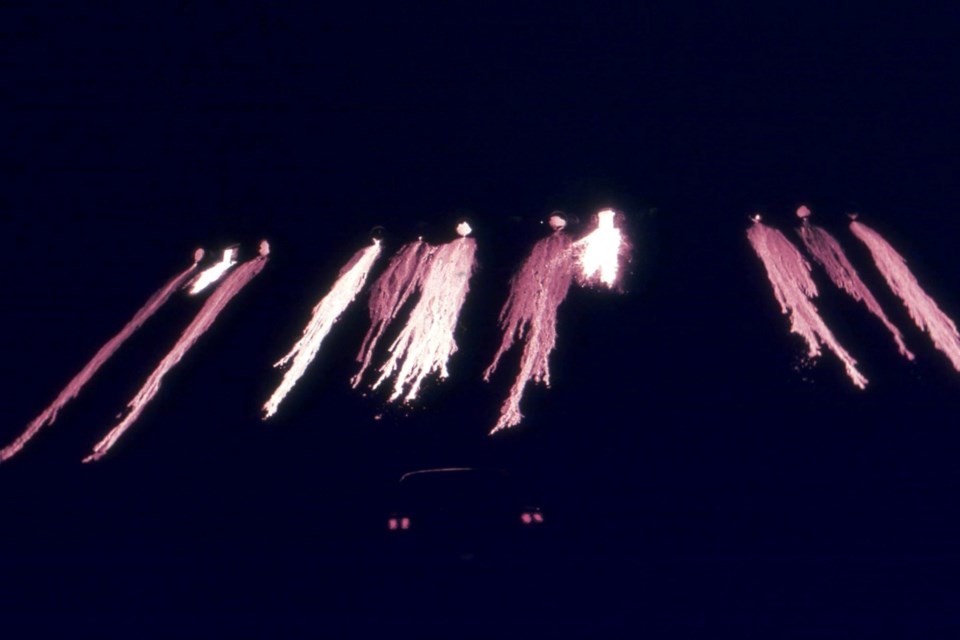
Of course, since most of the children were staying up late, many parents used this as a part of the pre-bedtime ritual. As Pat Langlois wrote, as children, they “loved going there with our parents and in our pjs it was a sight to behold … then it was home to bed.” However, the ritual did not preclude one last treat for the day, as Roger Sabourin wrote, “I remember our parents taking us out for DQ then taking us there to watch the dumps, in our pyjamas too!”
Now, not only did adults bring their children to watch the flowing lava of Sudbury’s own quasi-volcano, but many times they would also regale their out-of-town guests with the sight (sounds and smells, optional).
As reader Linda Derkacz wrote, “Many times our relatives would visit from Southern Ontario and THIS was a definite must-see event.”
Catherine Yurich-Gratton “remember(s) as a kid going with my parents and company from out of town to watch this. It was hot even from the road (and) it was so cool to see.”
As the slag pour was such a regular occurrence in the West End, reader Jim Roulston could view it every night from either bedroom or kitchen windows at his home on Sandra Boulevard. He laments that “the only problem was that when we had company from out of town, they would be staying in one of the back bedrooms and when the slag poured at night, they would wake us up to share the view with them.”
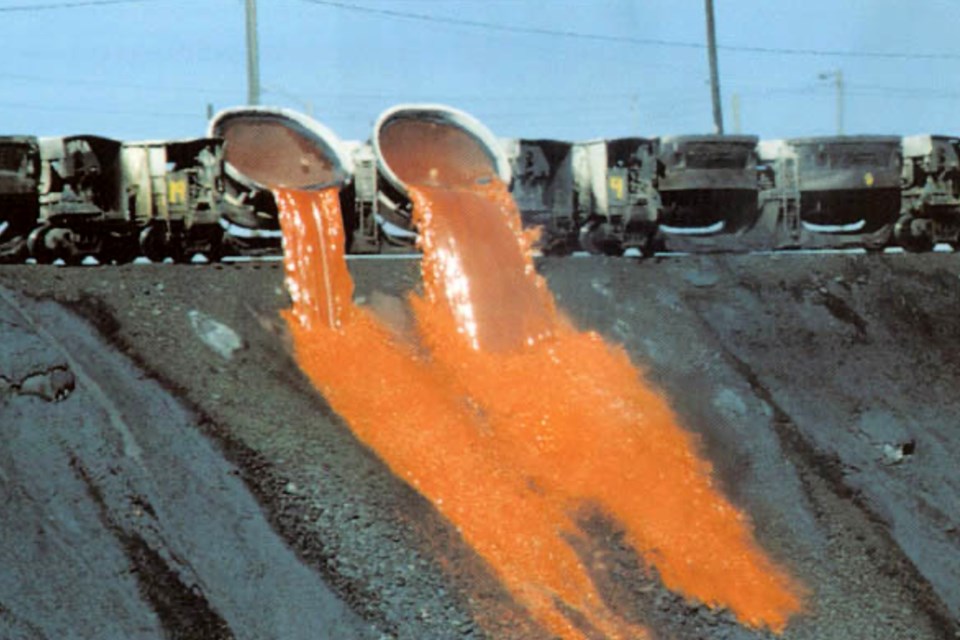
For many people, instead of travelling down to the West End to view the slag pour up close and personal, they chose to stay closer to home while still being able to enjoy the same scene that the others did near the foot of Sudbury’s man-made mountains.
Joy Knuff wrote that as her family lived on Martindale Road, “we would sit on the rocks behind our house to watch the slag dump. If we went half way up the hill we would have a clear view at night of molten lava pouring down the black slopes and the dark sky glowing an orange-red colour … Those were the days.”
At the other end of the city, Mary-Jayne Johnston “watched the slag pour every night from (her) parents bedroom window.” And, even though they “lived in New Sudbury on the Moss Street hill” she considers it a “great view of the glowing slag lighting up the sky orange!”
Another reader, Cathy Pigeon could not only see the glowing slag from her family’s home on nearby Victoria Street, but could also “feel the heat from our upper bedroom open windows.”
This makes one wonder about the sheer amount of heat generated at ground zero of the slag hill, as reader Dyann Lebreton “remember(s) sitting in our car, in the parking lot below the slag feeling the heat through the windshield.”
For some readers, the view of the slag pour was integrated so much within their lives that it was habitually included within more mundane parts of everyday life. For example, Sandy Oben “used to watch it every evening while doing the dishes with my grandmother, at the corner of Buchanan St. and Sandra Blvd.”
Now, speaking of mundane parts of everyday life, as Petra Casas wrote, “For me, watching the slag dump was the norm, as we watched it daily as we played outside at recess, often seeing it multiple times a day.”
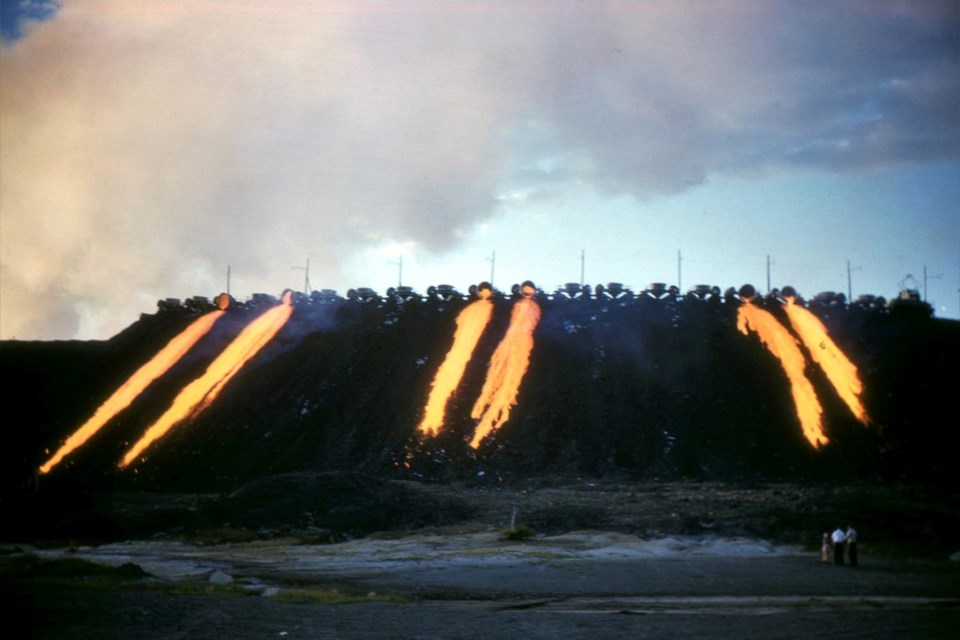
Nevertheless, as she continued, “in summer, my friends and I would ride our bikes in the large parking lot of Our Lady of Perpetual Help Church … and watch the last dump as the sun set. That was always so beautiful.”
She also remembers that the dumping of slag in the winter brought with it a little jolt that might (as the saying goes) wake the dead. As she recalls, “when it was very cold, there’d be a loud “BOOM” when the slag hit the cold snow. That did not happen very often, and I remember that scaring me a bit.”
A different kind of fear came up in the memories of a couple of other readers, and instead of being tied to the sounds emanating from the slag dump, this fear came from its sheer brightness as it illuminated the night sky.
Marlene Semenchuk, who was five years old the first time she witnessed the slag being dumped, remembers it in this way. “We were just moving into our house in Gatchell at night when I went outside. It was winter and the slag was pouring, I went (back) into the house yelling the sky is on fire! My mom explained to me what it was! It was spectacular to see. It is and will always be a beautiful memory.”
On the other hand, Bill Gordon, who lived on Sandra Boulevard from about 1958 to late 1963, recalls the slag dump being a regular nightly event viewed from the back bedrooms of his house. However, he remembers vividly one night when his brother asked their mother, "Is that Hell?”
A few of our readers wrote to us reminiscing about some of the riskier activities they took part in around the slag dump when they were young (don’t worry, none of them broke the law … maybe).
A reader over at our website remembers that “in the mid-70s we hung out at the slag pit, scampering across the cooling slag to shatter the ‘bubbles’ of thin rock.” As she continued, there were “many a melted sole (on) running shoes to explain!”
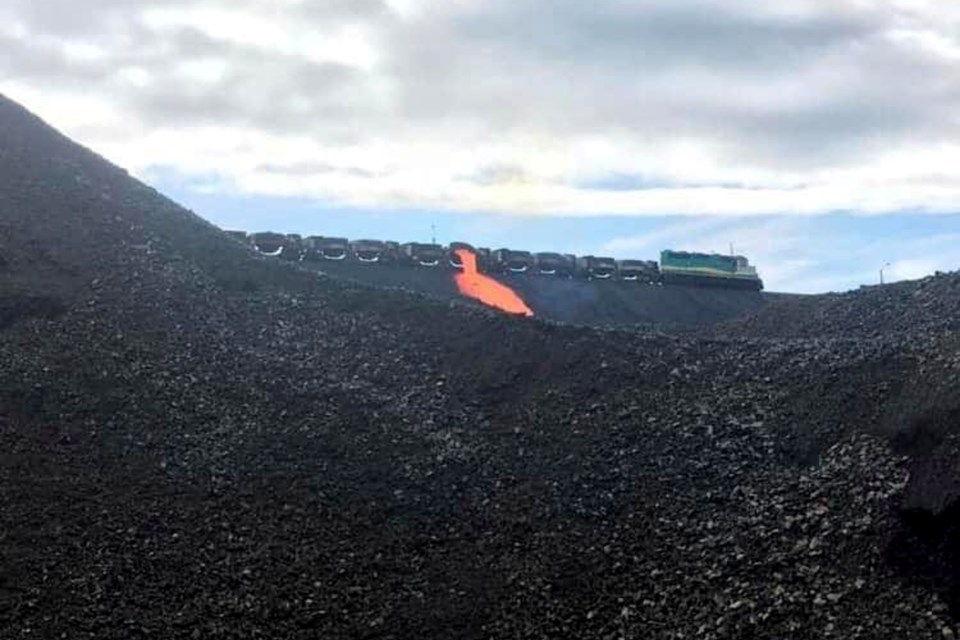
Another reader, Tim Bolton, confirms that this type of activity was commonplace, as he has “fond memories of being able to get so close you could feel the bottom of your running shoes starting to get soft.” (Clearly, safety and liability were not front and centre in people's thinking back then, right, Tim?)
Gary Johnson remembers those days as well, but in his case, he and his friends “used to walk right up to the edge and throw sticks in the lava to watch them be devoured!”
While, a further reader at our website would sneak up close “after it was closed off and watch slag pours (where) we were only meters away and had to hide behind large rocks to shield us from the heat.”
Ted McChesney reached back into the distant past (63 years to be exact) to give us a great story of the adventures of two friends out on the slag dump.
He writes that “when I was 13, a buddy and I went into INCO property to view the Slag Dump ‘up close’. We were lying on our backs in the snow, about 50 feet from the base of the hill. Once the slag started pouring and the snow we were seated on melted, we obviously decided that we were too close to the hot slag!”
He continued, “We started running away and were spotted by the train crew. Presumably, they reported our presence and there were two Skidoos put on our tail. The Copper Cliff Police that stopped us, took our names and where our fathers were employed. My pal had no problem, since his dad worked at Falconbridge. Now my father, he was a shift boss at Frood Mine and I had innocently risked his job by my actions the previous night! Believe me, I never, ever, went on INCO property again.”
Not only were locals (and their guests) enamoured by the slag pour, but many times tourists (sometimes to the bewilderment of us locals) were attracted to this sight.
Petra Casas remembers those tourists well. As she wrote, “Living next door to Don’s Pizzeria (at the corner of Byng and Lorne Streets), it was not uncommon to have tourists stop for dinner and from the parking lot ask us kids where they could go to watch the slag dump. We usually directed them to the church, and although I thought it was beautiful, it was so normal to me, I remember not really understanding why someone would come from far away to see it.”
Reader Anne Marie Mills related another story here on our website, involving some misguided tourists.
“I will never forget sitting on Bulmer Avenue watching the slag dump in July when tourists from the U.S. pulled up,” she wrote. “They had downhill skis on the roof of their vehicle and thought we were far enough north that they would find snow.” But, in the end, the black hills bulging out from Copper Cliff attracted their attention and “they were mesmerized by the slag dump.”
Incidentally, as it pertains to those tourists from long ago, a few readers, as a part of their reminiscences, lamented the city’s loss of potential tourism when the slag pour was moved behind the curtain (so to speak) and out of view.
One reader wrote, “Sudbury is missing out on a unique tourist opportunity. Although there is less slag dumping, it still happens. City officials should talk to Vale and see if there is a way to set up a safe, fenced in viewing area, especially for the summer months. Cooperation could result in an online viewing schedule.”
As another reader, Richard Lalonde, added, there are “many good memories there, I wish they would bring it back so we could easily watch, it was an affordable outing.”
And, as Petra Casas added at the end of the memories that she shared with us, “I can say that I now miss it and wish my kids and husband could have seen it. It really was quite a sight.”
Well dear readers, thank you brightening up our day (with an orange and red vibrancy, no less) by sharing your memories with us of slag, or as reader Chrystia Chudczak put it “Sudbury's 4 letter word” (Hint to Up Here Festival, could make a great t-shirt). We’ll see you back here again in two weeks with another timely topic from our shared history.
Jason Marcon is a writer and history enthusiast in Greater Sudbury. He runs the Coniston Historical Group and the Sudbury Then and Now Facebook page. Memory Lane is made possible by our Community Leaders Program.
